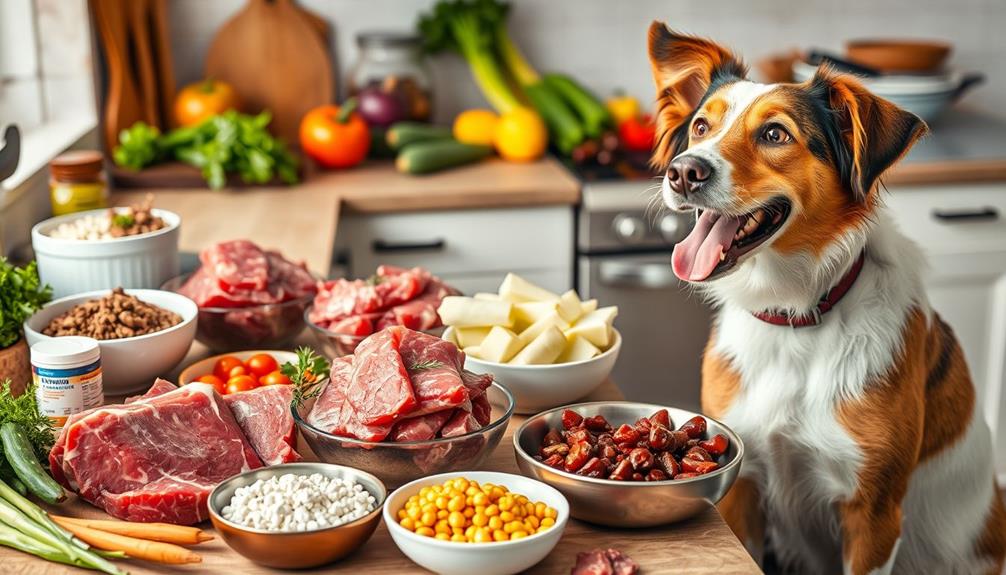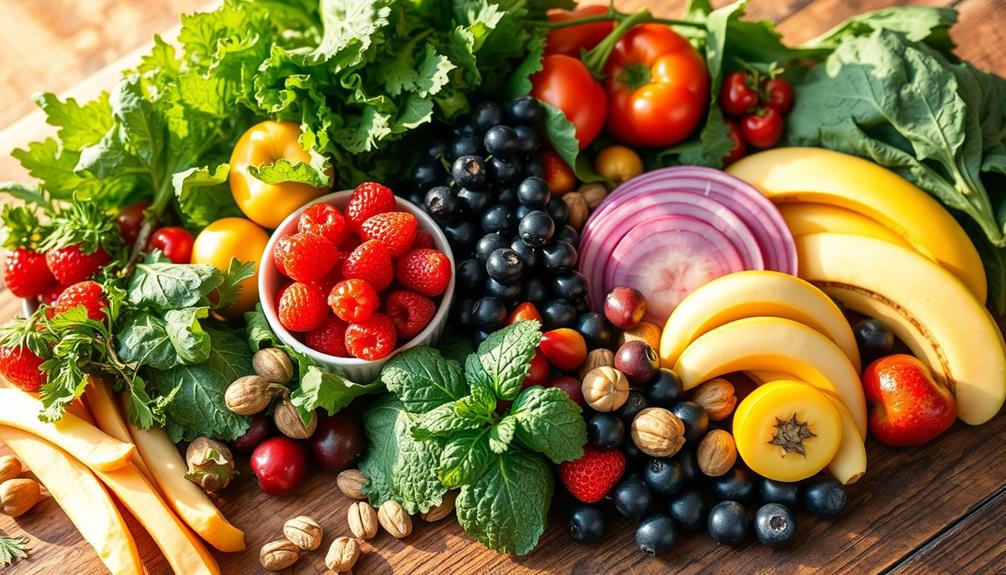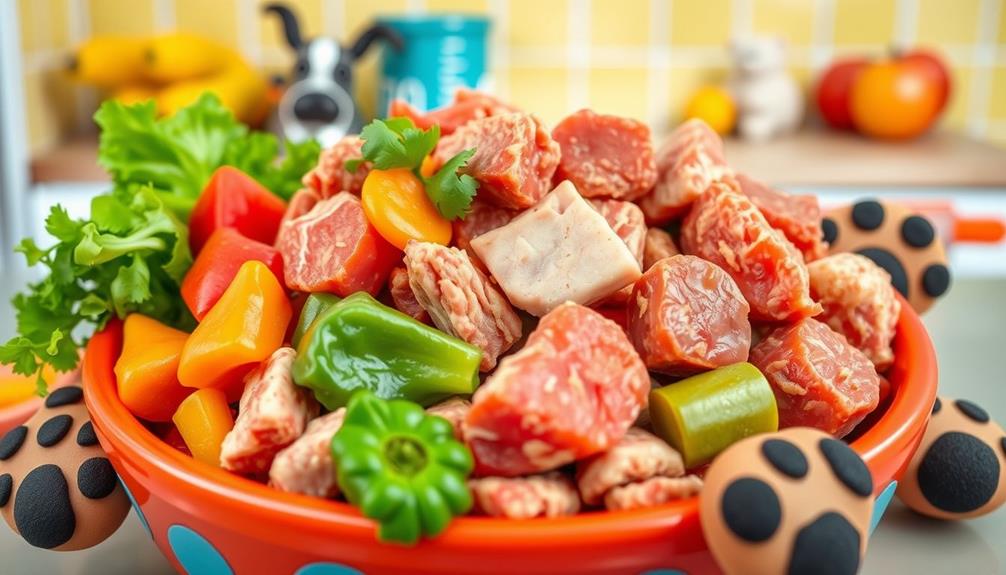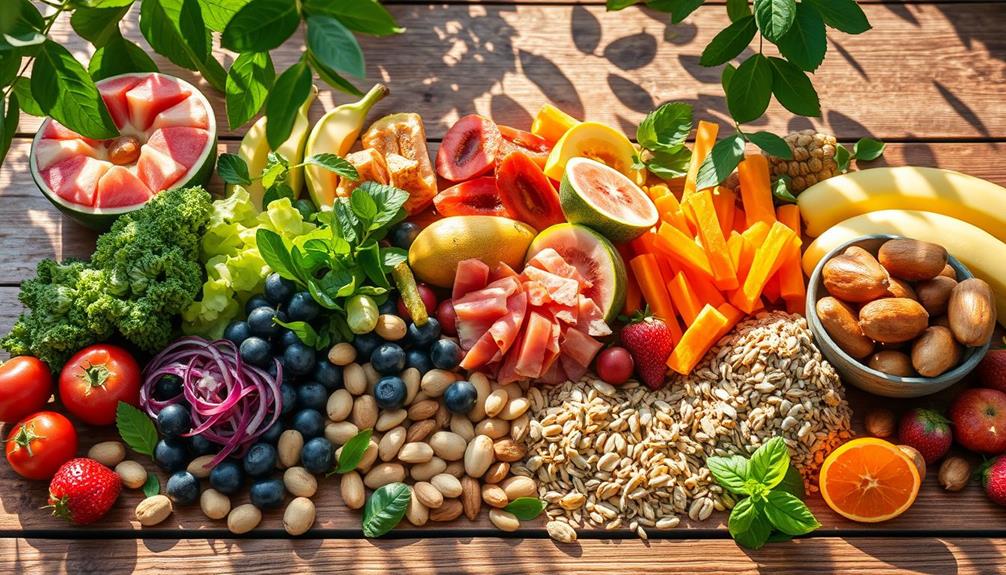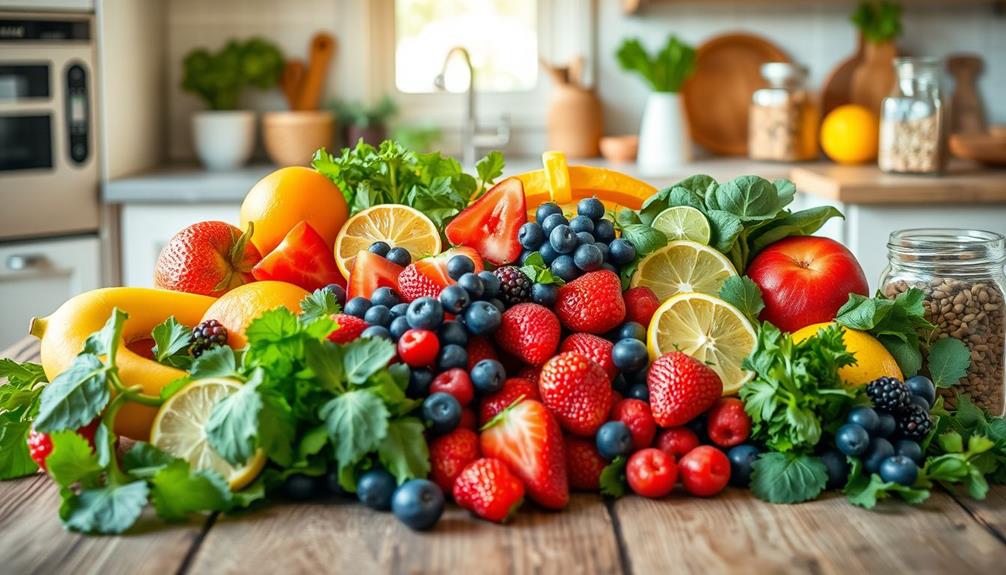To feed your dog a raw food diet, aim for 2-3% of their ideal body weight each day, adjusting based on their activity level. For instance, active dogs may need closer to 3%, while less active ones might do well with 2-2.5%. It's best to divide their daily portion into two meals for peak digestion. Puppies require about 5% of their body weight daily, spread across multiple meals. Always monitor your dog's weight, energy levels, and overall health to guarantee they're thriving. There's plenty more to discover about balancing nutrition and sourcing quality ingredients.
Key Takeaways
- Feed 2-3% of your dog's ideal body weight daily, adjusting based on activity level and individual health needs.
- For puppies, provide at least 5% of their body weight daily, split into 2-3 meals for optimal growth.
- Gradually transition to a raw diet over a week to minimize digestive issues and monitor weight closely.
- Include a balanced mix of muscle meat, organ meat, and finely ground bone for optimal nutrition.
- Regularly check your dog's weight, energy levels, and coat condition to assess dietary effectiveness.
Benefits of a Raw Diet
Many dog owners are discovering the benefits of a raw diet for their pets. One of the most noticeable changes you might see is an improvement in your dog's skin health and coat. Dogs fed a raw diet often have a shinier coat, reflecting better overall health.
You may also notice enhanced energy levels; raw diets promote better nutrient absorption than kibble, leading to more active and lively pets. Additionally, a raw diet can be rich in antioxidants, similar to how cranberry juice consumption offers health benefits for humans.
Furthermore, shifting to a raw diet can help reduce allergies and skin issues, making your dog more comfortable. If your furry friend has been struggling with itching or irritation, this alteration could provide relief.
Another significant advantage is improved dental health. The natural chewing that comes with raw feeding can help reduce plaque buildup, keeping your dog's teeth healthier.
Even if you include just 25% raw food in your dog's overall diet, you can still experience substantial benefits, such as fewer allergy symptoms and enhanced digestion efficiency.
Incorporating a raw diet can lead to a happier, healthier dog, so it's worth considering the positive impact this dietary change might've on your pet's life.
Calculating Raw Food Portions
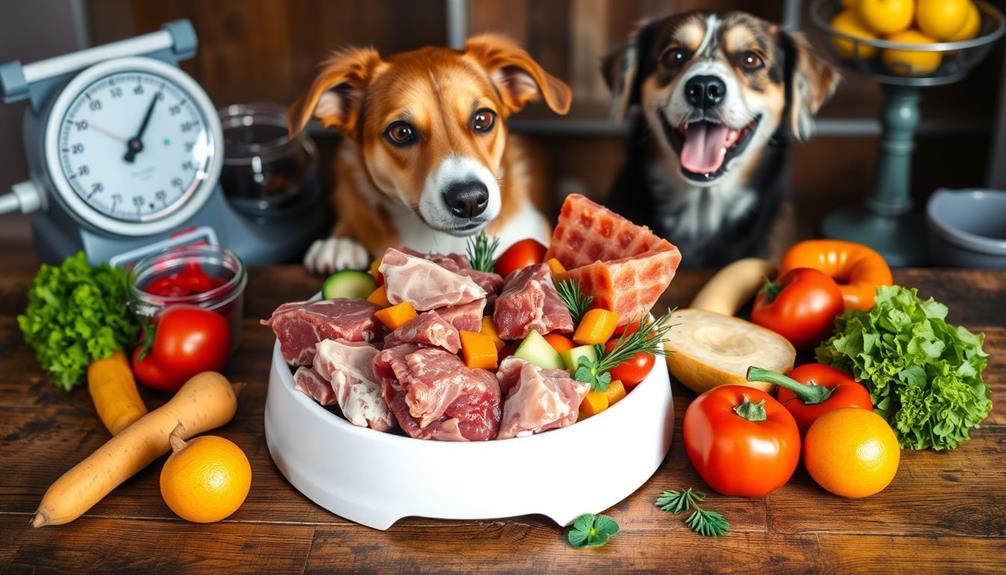
When determining how much raw food to feed your dog, start by calculating 2-3% of their ideal body weight daily. This percentage can be adjusted based on your dog's activity level and overall health. For instance, active dogs might require closer to 3%, while less active ones should be around 2% to 2.5%.
Here's a quick reference table to help you calculate the appropriate amount of raw food:
| Dog Weight (lbs) | Recommended Percentage (%) |
|---|---|
| Up to 5 | 5-6 |
| 6-20 | 4-5 |
| 21-50 | 3-4 |
| 51-100 | 2-3 |
| Over 100 | 2-2.5 |
Feeding Frequency Recommendations

Deciding how often to feed your dog can greatly impact their digestion and overall well-being. For adult dogs on a raw food diet, it's generally recommended to split their daily food intake into two meals per day. This approach aids digestion and helps prevent issues like bloat.
While many pet owners follow this twice-daily feeding frequency, some opt for once daily, and a few even choose three or more meals, depending on their dog's specific needs. It's important to monitor your dog's health closely, as proper diet and ultimate hamster care principles can also apply to guaranteeing your dog receives balanced nutrition.
If you have an active dog, you may notice they thrive on regular meal times, which can help maintain their energy levels. Puppies, on the other hand, require more frequent feedings; very young puppies (5-8 weeks old) need 3-4 meals a day, while older ones do well with twice-daily meals.
Always keep an eye on your dog's body condition and overall health when determining the best feeding frequency. Some dogs may benefit from smaller, more frequent meals, especially if they've unique dietary requirements or health concerns.
Adjust their meals based on these observations to guarantee they stay happy and healthy.
Transitioning to a Raw Diet
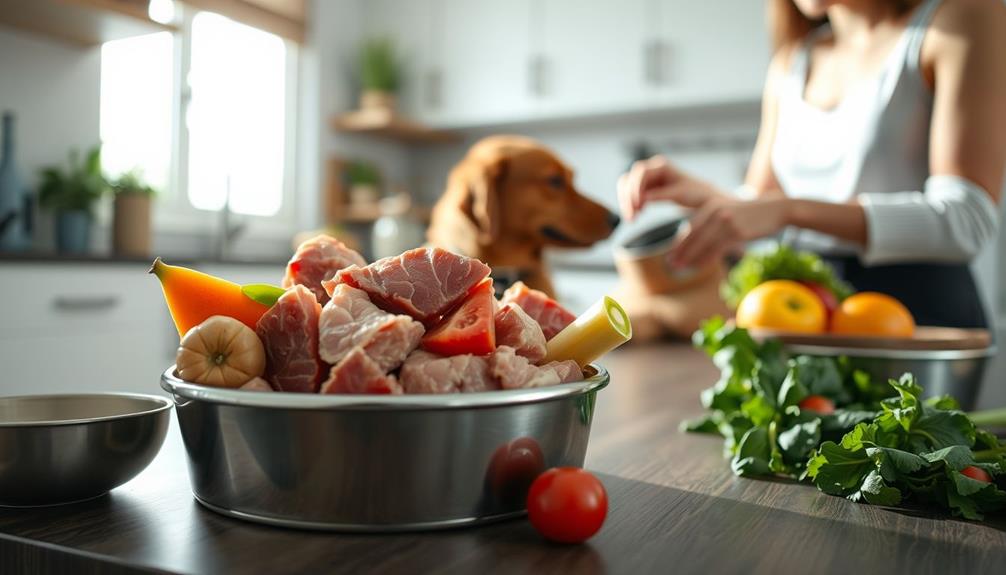
Shifting your dog's diet to raw food can be a rewarding journey, but it requires careful planning and attention. When adapting to a raw diet, start by introducing raw food gradually over a week. This gradual adjustment helps minimize digestive issues your dog might face while acclimating to the new diet, and incorporating a variety of ingredients can enhance the nutritional benefits of their meals.
For instance, adding essential oils for toothache relief can support oral health while they adjust to new food textures. Begin with a small portion of raw food, and increase it incrementally.
During this adjustment, it's vital to monitor your dog's weight closely. Aim for no more than 1-2% weight loss per week, primarily due to water weight. Healthy dogs can usually adapt within a week, but if your dog has existing digestive issues or sensitivities, be prepared for a slower progression that may take several weeks.
You might want to start with a base mix of dehydrated vegetables or fruits in such cases.
Always consult with a veterinarian throughout this process to maintain your dog's health and nutritional balance. They can help guide you on the appropriate raw food portions and monitor any potential concerns.
Guidelines for Puppies
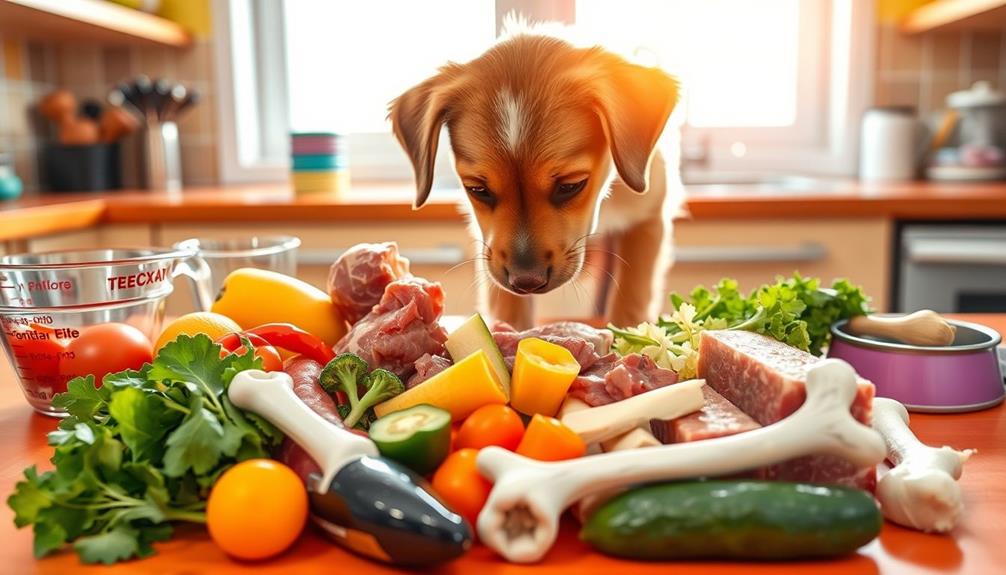
When it comes to feeding puppies, you'll want to guarantee they get enough nutrition to support their rapid growth and emotional development.
Aim for at least 5% of their body weight daily, split into 2-3 meals, and adjust the portion size as they approach their ideal adult weight.
Key domains of development emphasize the importance of proper nutrition during these formative stages.
Don't forget to monitor their weight and growth closely to keep them on track for healthy development.
Feeding Frequencies for Puppies
Feeding your puppy the right amount and frequency is essential for their growth and development. For very young puppies aged 5-8 weeks, it's important to feed your puppy three small meals a day. This supports their rapid growth during this critical stage.
As your puppy gets older, typically around 8 weeks and beyond, you can shift to feeding them twice daily. This change aligns with their developing routine and prepares them for adult feeding habits. Additionally, consider monitoring your puppy's overall health and energy levels, as these can also indicate whether they're receiving adequate nutrition and hydration.
For more information on dietary needs, refer to this nutrition guide.
The amount of food you provide should be based on your puppy's age, weight, and breed. Generally, aim for about 10% of their current weight or 2-3% of their ideal adult weight per feeding.
Close monitoring of your puppy's growth is essential, so be prepared to make adjustments to their food intake as needed. If they're gaining weight too quickly or not enough, tweak the feeding schedule accordingly.
Portion Size Recommendations
As your puppy grows and you adjust their meal frequency, it's important to focus on portion sizes to guarantee they're getting the right amount of nutrition. Following the guidelines in "How Much Raw Food to Feed a Dog: Essential Guidelines," you'll want to take into account these portion size recommendations: Understanding your puppy's financial health can also help you budget for their food needs over time.
- Daily Intake: Feed your puppy 2-3% of their ideal adult weight or about 10% of their current weight daily.
- Meal Division: Split their food into three meals throughout the day for ideal growth and energy.
- Example Calculation: If your puppy is expected to weigh 50 lbs as an adult, they'll need about 1-1.5 lbs of raw dog food each day.
- Monitor Growth: Keep a close eye on your puppy's growth, adjusting food quantities as needed to support healthy development and weight management.
Starting with 1-2 recipes guarantees balanced nutrition and proper digestion.
You can also enhance their raw diet with supplements like fish oil, kefir, or probiotics.
Choosing Quality Raw Food
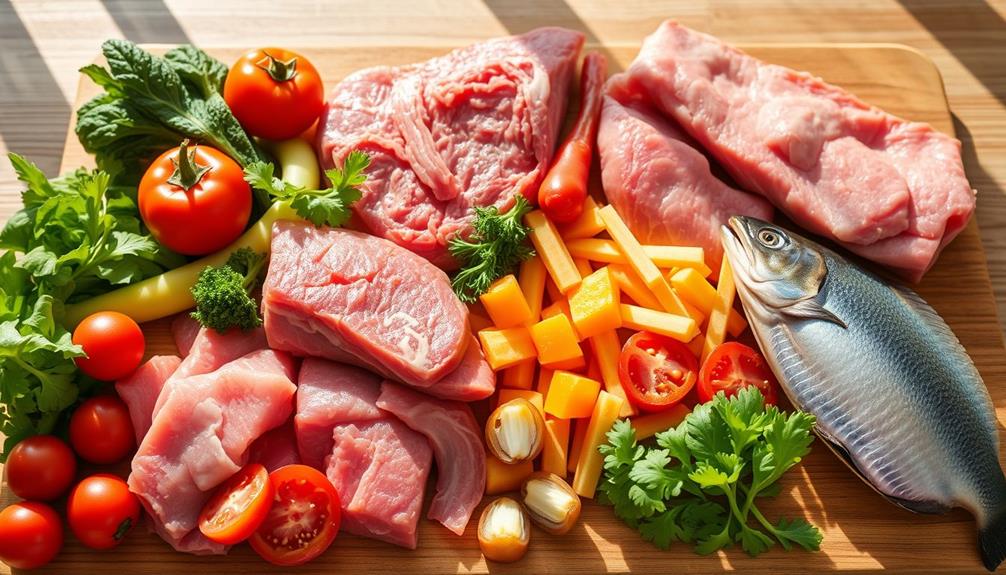
When choosing raw food for your dog, ingredient quality is key.
You want a balanced mix of muscle meat, organ meat, and bone to meet your pup's nutritional needs without any fillers.
Proper piercing care and hygiene is essential to avoid infections, which can also apply to your dog's health by guaranteeing their food is free from contaminants.
Always check the sourcing and nutritional value to guarantee you're giving them the best possible diet.
Ingredient Quality Matters
Choosing the right raw food for your dog hinges on the quality of its ingredients. The nutritional value of raw pet food depends greatly on what goes into it. High-quality ingredients can make all the difference in your dog's health, just as understanding financial considerations for elderly care is vital for securing a healthy future for loved ones.
Here are some factors to take into account:
- Ingredient Sourcing: Opt for brands that prioritize local sourcing. This often means fresher and more nutritious options for your dog.
- Transparency: Choose a reputable brand that openly shares information about its ingredient sourcing and preparation methods. This guarantees safety and consistency.
- No Fillers or Additives: Avoid brands that use artificial additives or fillers. Your dog's diet should be free of unnecessary ingredients that compromise health.
- Complete and Balanced Meals: Confirm the raw food includes a mix of muscle meat, organ meat, and finely ground bone to provide all essential nutrients.
Nutritional Balance Essential
A well-balanced diet is essential for your dog's health, and that means incorporating the right mix of muscle meat, organ meat, and finely ground bone in their raw food. This combination guarantees your dog receives the complete nutrition they need to thrive.
When you feed dogs raw food, it's critical to choose products that prioritize quality. Not all raw dog food is created equal; opt for options free from fillers, preservatives, and artificial additives to maximize their nutritional value. Additionally, consider the benefits of using essential oils for skin conditions that can support your dog's overall wellness alongside their diet.
Ingredient quality and sourcing play a significant role in the food's overall benefits. Always look for hormone-free and antibiotic-free options to support your dog's health.
We Feed Raw offers meals designed to meet your dog's nutritional needs at all life stages, assuring they enjoy a balanced diet throughout their lives.
Additionally, regular quality control measures and safe preparation methods are fundamental to maintaining the nutrient retention and palatability of raw dog food. By choosing high-quality raw food, you're not just feeding your dog; you're investing in their long-term health and happiness.
Monitoring Your Dog's Health
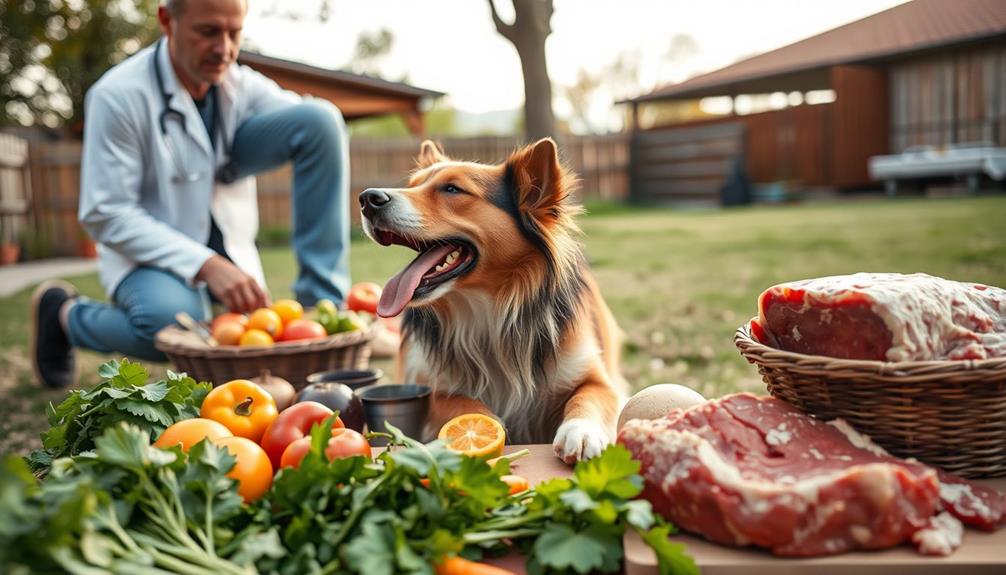
Regular monitoring of your dog's health is crucial for guaranteeing they thrive on a raw food diet. By keeping an eye on various aspects of their well-being, you can make necessary adjustments to their diet and improve their quality of life.
Here are four key areas to focus on:
1. Monitoring your dog's weight: Regularly check their body condition to confirm they stay within a healthy range. Adjust food portions based on their activity level and any weight changes.
Consider incorporating healthy dog snacks to help maintain their weight and energy levels.
2. Energy levels: Observe your dog's overall liveliness. A noticeable increase or decrease in energy may suggest the need for dietary adjustments.
3. Coat condition: Pay attention to your dog's coat and skin health. Improvements in these areas can indicate better nutrient absorption from their raw diet.
4. Digestion: Track your dog's digestion, including stool quality and frequency. Smaller, firmer stools often signal efficient digestion and nutrient absorption.
If you notice any adverse reactions or health issues during the shift to a raw diet, consult with an integrative veterinarian.
Keeping a close eye on your dog's health will help guarantee they thrive on their new diet.
Common Misconceptions
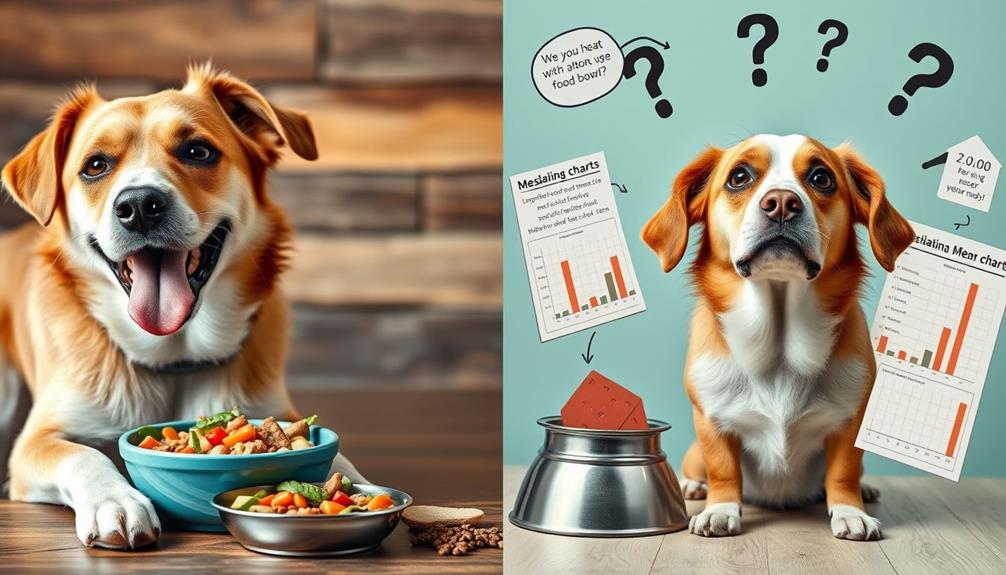
When it comes to feeding your dog a raw diet, misconceptions abound that can lead to confusion and misinformed choices. One common misconception is that all dogs should eat the same percentage of their body weight. In reality, factors like age, activity level, and health matter, with most adult dogs needing 2-4% of their body weight daily.
Many believe feeding once a day is best, but studies show that 75% of We Feed Raw customers feed their adult dogs twice daily for better digestion.
You might think raw diets require more food than kibble, but that's not the case. Raw food is more nutrient-dense, meaning you can feed less volume while still meeting your dog's needs.
Another misconception is that shifting to a raw diet should be quick; a gradual shift over a week is best to prevent digestive issues.
Finally, don't assume smaller dogs need less food than larger breeds. They often require a higher percentage of their body weight—up to 5-6% for dogs under 5 lbs—due to their faster metabolism.
Understanding these common misconceptions will help you create a balanced diet for your active dog.
Resources for Pet Owners
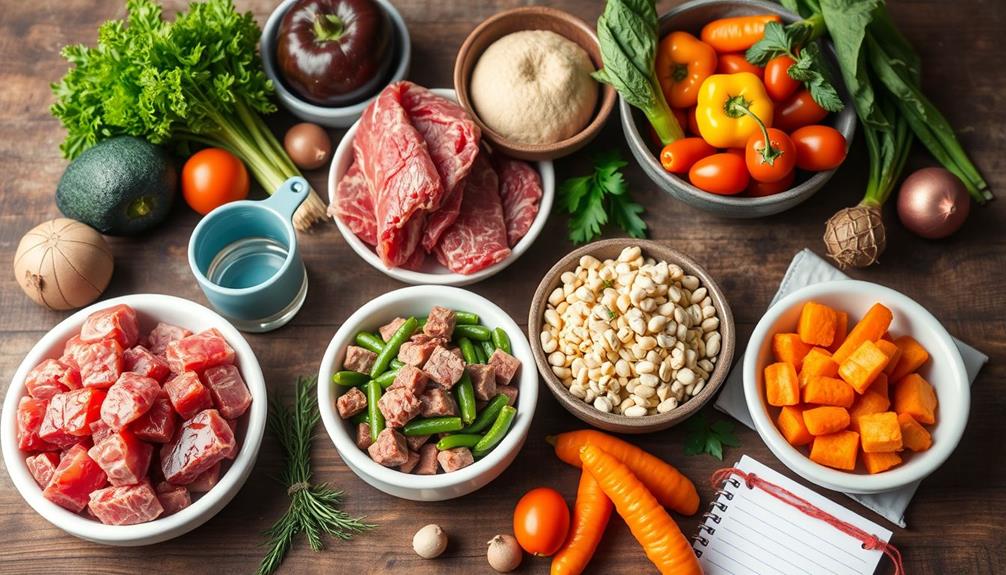
Finding the right resources for changing to a raw food diet can make all the difference for you and your dog.
With the right information, you can guarantee you're feeding your dog a balanced diet that meets their needs. Here are some essential resources to help you along the way:
- Raw Feeding Calculator: Use the We Feed Raw feeding calculator to determine how much raw food your dog needs. Just input your dog's weight and the desired percentage to get the recommended amount to feed.
- Subscription Services: Consider subscribing to a raw dog food service that delivers fresh meals directly to your door. This guarantees you have a regular supply of balanced meals without the hassle.
- Educational Guides: Look for educational resources on raw feeding. These can offer tips for managing picky eaters and explain the benefits of a raw diet.
- Veterinary Collaboration: It's recommended to collaborate with an integrative veterinarian during this change. They can help you guarantee your dog's diet is nutritionally balanced and address any specific health concerns.
Frequently Asked Questions
How Much Raw Food Should I Feed My Dog Chart?
To find out how much raw food to feed your dog, consult a feeding chart that considers their weight and activity level. Adjust portions based on their size, age, and overall health for ideal nutrition.
How Much Raw Food Does My Dog Need a Day?
When it comes to feeding your dog, it's a balancing act. Generally, you'll want to provide 2-3% of their body weight in raw food daily, adjusting based on activity level and health needs.
What Is the 80 10 10 Rule for Raw Dog Food?
The 80/10/10 rule means you should feed your dog 80% muscle meat, 10% organ meat, and 10% bone. This ratio guarantees they get essential nutrients for ideal health and digestion.
What Is the Best Raw Food Ratio for Dogs?
Think of your dog's diet as a finely tuned orchestra. To hit the right notes, aim for 2-3% of their body weight daily, adjusting based on their activity, age, and health for harmony.
Conclusion
Incorporating a raw diet for your dog can be as rewarding as watching a flower bloom. By understanding portion sizes, feeding frequency, and the right quality of food, you'll nurture your furry friend's health and happiness. Remember, every dog is unique, so keep a close eye on their well-being as you evolve. With patience and care, you can create a nourishing experience that brings out the best in your beloved companion. Embrace this journey together!

